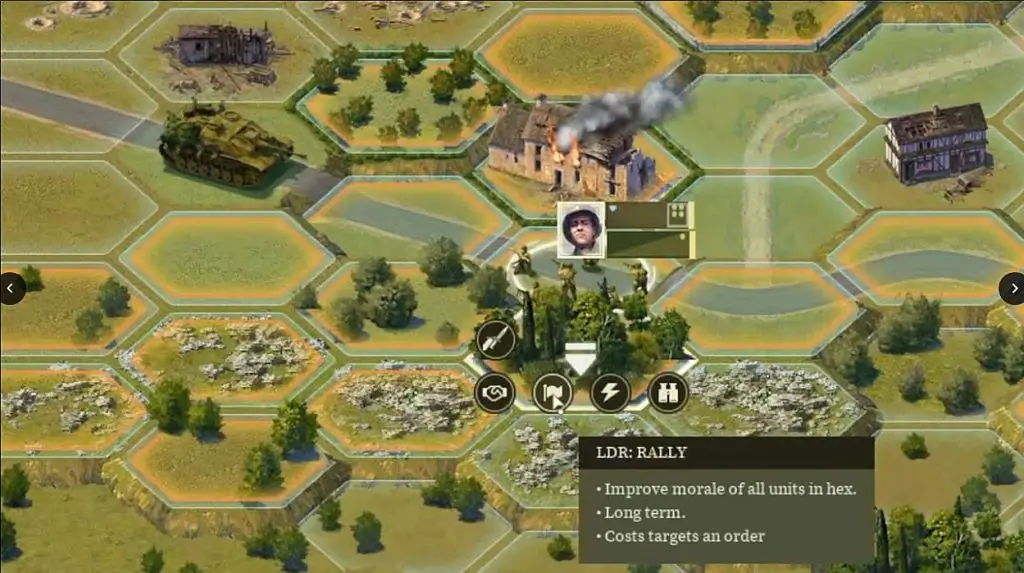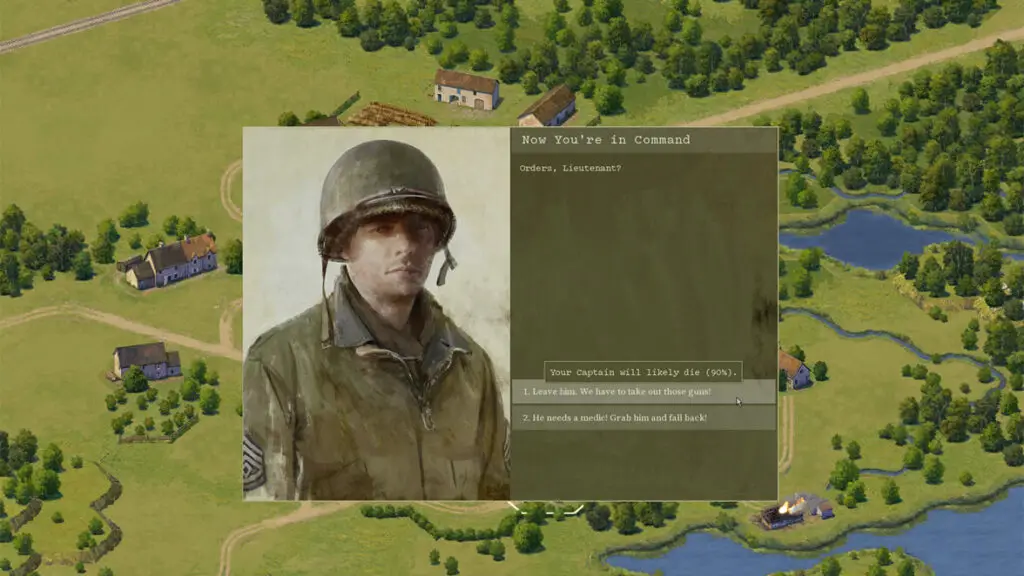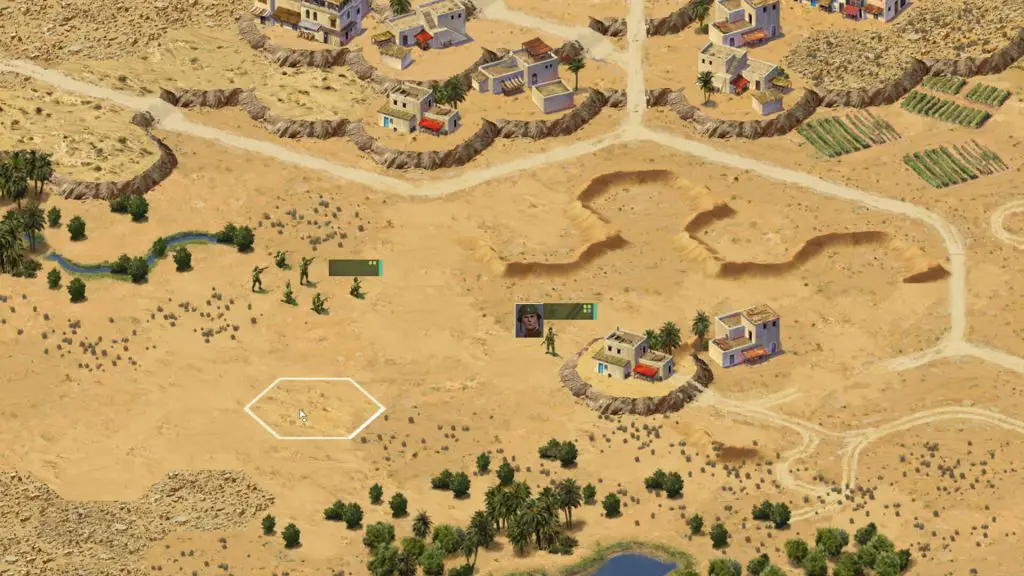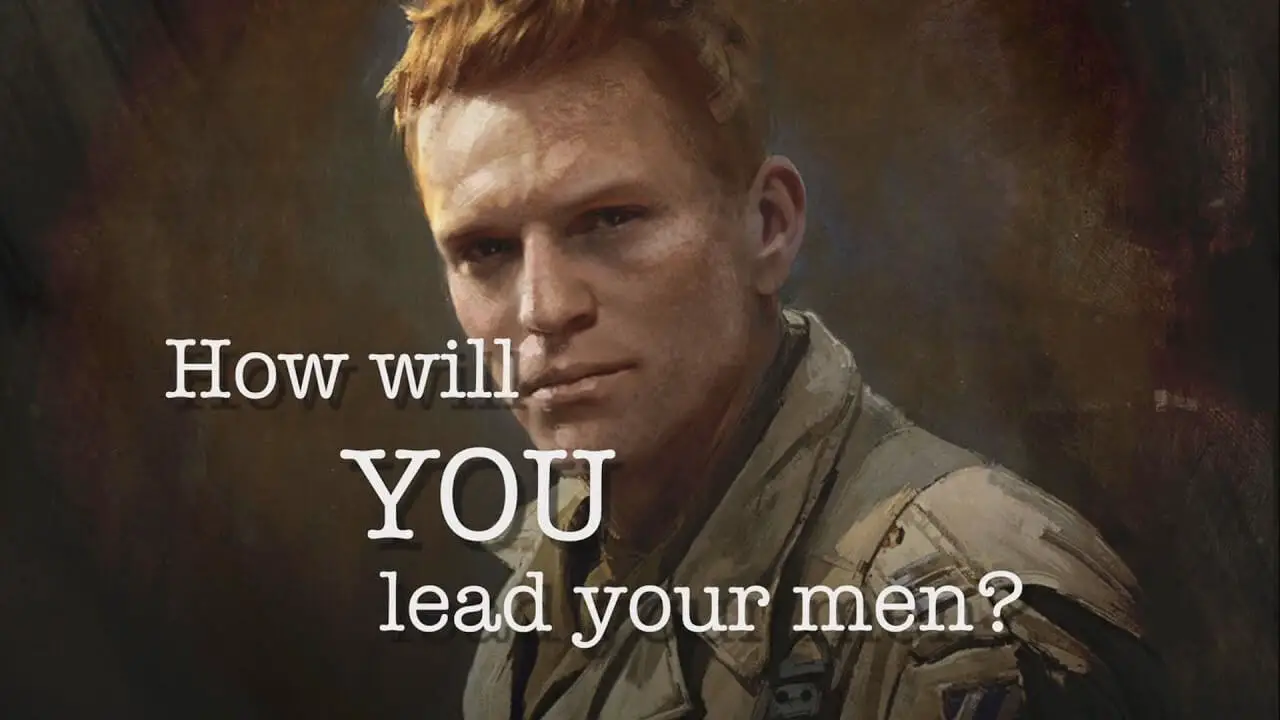I did not expect a single playthrough of Burden of Command to take me 60 hours, but here we are. Am I complaining? Only about myself, for not putting the nose to the grindstone earlier. Because if you’re at all interested in World War 2 gaming – or even weirder RPGs – you should play Burden of Command.
In the game, you’ll be commanding the N – Nickel – company of the 7th Infantry Regiment of the US Army – the “Cottonbalers.” Considering that the 7th is the infantry unit to have seen the most campaigns in the US Army, you’re going to follow it to North Africa, Sicily, Italy, France, and then Germany. And as a captain, you’ll have under your command three platoons of foot-slogging GIs and a weapons platoon to back it up. If you’re lucky, a tank may wander in to keep your company or artillery larger than your single 60mm mortar may become available.

I’m ordering you to read the field manual
So that’s all and clear thus far. But as you’re thrust into the lengthy tutorial, you’ll find that Burden of Command is weird. It’s turn-based, sure, that’s easy to understand. But the turns are broken down into leadership pulses or phases. One of your leaders commands a unit to act, then the enemy does. If both pass activation, the turn ends.
During the leadership pulse, a leader – usually a lieutenant – can expend one of his orders to activate a subordinate unit. The captain exists as a wildcard: he can order any unit in the company and doesn’t have to stack with a unit to boost it – being in an adjacent hex is enough.
After that initial leader orders expenditure, that subordinate unit spends its own orders to move and attack. However, if you pass the leadership phase, that unit will have to be activated again at a cost!
Of course, leaders expend orders to do stuff for themselves – namely, moving around. While a leader can book it much faster than a squad, that’s still at least an order expended per leg. So keep your platoons close together. This is doubly important due to the emphasis placed on morale.
This kills the Warhammer 40K player
Burden of Command may be the title of the game, but morale is the name of the game. Will you shoot first in a firefight? Will the squad launch an assault? Will the squad move under the threat of fire – or at all advance towards the enemy? How many orders does it have each turn? All of this is determined by morale.

Oh, and in the grand tradition of hex-and-chit gaming, units don’t rally themselves. Without a lieutenant there to kick their ass, a suppressed squad will hug the ground and pretend that professional NCOs in the shape of sergeants aren’t the basis of all Western militaries.
So the leaders can rally a squad that hasn’t spent any orders yet, incidentally rallying themselves as well. But rallying a squad expends all of their orders, so you’ll have situations where it’s much better to get a temporary morale Boost.
Oh Lord, you’ll be boosting so much you’ll swear you’re playing Need For Speed: Underground. Especially since boosting is imperative for launching assaults on enemy positions – you need to pass the morale test to fix bayonets and get that increased movement range. Since enemy units are very hard to shoot dead, especially with infantry small arms, you’ll be assaulting all the time.
It’s frankly comical how many assaults you’ll launch, especially considering that the most likely outcome is that a well-suppressed enemy will give up. The game doesn’t run a tally of prisoners taken, but I expect each mission to end with about as many prisoners as I have troops.
Does this make Burden of Command sound complicated? Well, that’s because it is, but only a little. Once the interminably long tutorial is over and you’re finally let loose, you’ll quickly learn the ropes. Just beware: this leadership RPG takes things seriously and saves after anything you do.
command point is for reading papers
This is important on the battlefield, sure, but also in the text-adventure parts. And Burden of Command is next to 50% text adventure by weight. Why? Because when you’re a captain in charge of around 100 men, you’re not just a battlefield leader. Only children and bad writers think that.

You will be tasked with decisions big and small, from whether a trooper should risk his life to fetch a dropped BAR to who’ll go on the patrol to scout out enemy positions – and how much risk they should take. You will be risking something all time – whether it’s Prestige (metacurrency for dealing with higher-ups) and Trust (metacurrency for dealing with your troops), battlefield positions or the lives of your troops.
The text adventures are a great tool that Burden of Command uses to convey the realities of war that 2D isometric view can’t. Friends dying. Interacting with civilians who don’t obligingly vacate the area. Losing men to venereal disease. Supply issues. Your men getting into trouble or your lieutenants getting increasingly worn down by war and loss. It’s a perfect look into the human aspect of war, most wargames don’t care to get into in favor of rushing to the next set piece and Tiger boss battle.
It also shows the ridiculous attrition rates of WWII infantry quite realistically.
Army boys make do
Burden of Command does so much with so little that you will forgive its flaws. And there are a million of them, mostly attributed to a lack of polish. Enemy units and allied forces alike will have placeholder names like AlliedTankLdr. Strings of text and pop-up material will be missing. The tutorial narrator tells you to ignore what is done in the tutorial video, while the subtitles tell you to ignore the narrator.
The most baffling thing has to do with portraits and insignia. You can’t customize the portraits for named characters, but you can choose the portraits and insignias for squads and platoons. However, whenever a friendly leader gets wounded, the replacement lieutenant always has the same portrait. When you have allied forces, they also use that same portrait. Do you have two platoons of tanks in support? Dang, they’re commanded by twins! And their platoon insignias are identical to the default logo of the 1st platoon – blue and white stripes.
Granted, this is nothing that patches can’t fix, and it doesn’t break the game, merely makes it harder to play.
But overall? I had a lot of fun with Burden of Command. Trust me, once you get out of the tutorial, it becomes a lot more interesting. Deadly, too, but what do you expect? It’s World War II!







